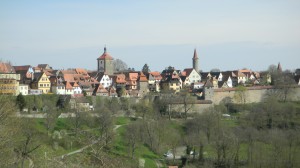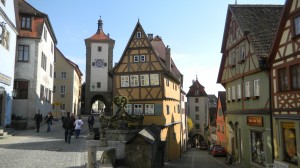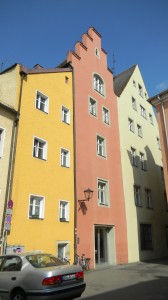Town air makes men free! This was a popular saying in the Middle Ages, and thousands of peasants deserting their farms and tax-happy lords resonated with it.
In many regions of Europe, people could win freedom from overlords by living in a town for a year and a day. A proud and industrious class of merchants emerged, and new types of experience and thought opened up.
1. Towns attracted people who wanted more excitement than the slow agricultural cycles. Young men played ball games in the market square, people drank ale and mead and shared songs and bawdy stories in taverns.
Wandering actors, acrobats and musicians performed in the town square. Actors sometimes made combat scenes more realistic with blood and guts from the local butcher. People playing devils sometimes ran through the crowd, pinching folks.
Fires were common. So were fights, rats, lice, and infections. There was no shortage of crap to step in. But people kept coming, in search for freedom, novelty and wealth.
2. Coins were increasingly used after being scarce since the Roman Empire. International commercial fairs emerged. The fairs in Champagne, France became meeting places for merchants from Italy and Flanders. Towns along the Baltic formed the Hanseatic League, which coordinate trade from the cloth producing towns in Flanders to Novgorod, Russia.
Farmers could now bring their goods to market and be paid in money. People began to use letters of credit, which would encourage the growth of banking in the 15th century.
People specialized into different trades and organized guilds. Many of today’s most common last names emerged then, like Smith, Baker, Miller, Barber, Carter, Mason, Tinker, Weaver, Potter, Tanner, Chandler, Roper and Fisher.
3. Literacy increased and spread beyond monasteries and royal courts, and literature in common tongues, like French, flowered. Courtly poetry and older Celtic myths (such as tales of King Arthur) reflected more refined tastes. People were getting bored with older sagas of men hacking each other to pieces. They wanted stories about love and the dignity of women, with descriptions of well furnished castles and elegantly dressed young men and ladies.
4. Etiquitte was increasingly valued. Books on table manners instructed people to avoid picking their teeth with their daggers, wiping gravy from their mouths with pieces of bread or the tablecloth, buttering bread with their fingers and spitting on the table.
The newly arriving farmers and angry younger sons from noble families were finding more than freedom–they were learning about civilized living.
So Gothic architecture emerged in societies that were becoming more wordly. Gothic cathedrals were supposed to integrate everybody within a spiritual universe under God. But their world was becoming more complex. Gothic art had to respond, and it became richer. We’ll explore more of it as we continue the series, The Many Worlds of Gothic Style.




Comments on this entry are closed.